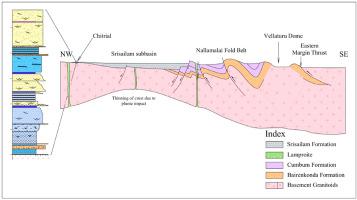Marine and Petroleum Geology ( IF 3.7 ) Pub Date : 2021-07-20 , DOI: 10.1016/j.marpetgeo.2021.105242 Himadri Basu 1 , P.S. Dandele 2 , S.K. Srivastava 1

|
Sedimentary facies of the Mesoproterozoic (~1400−1327 Ma) Srisailam Formation, exposed in the Srisailam sub-basin in the northern part of the Cuddapah basin, India, were analyzed. It helped in identifying eighteen different facies that can be grouped into six facies associations (FA-I to VI) – alluvial fan/fan-delta, delta top, delta front, lacustrine, fluvial, and aeolian. Hinterland geology, integrated palaeomagnetic, geochemical and sedimentological observations, and inferred palaeohydrological condition and palaeoclimate indicate more control of tectonic regime on the evolution of the facies architecture. Analysis of vertico-lateral disposition of the identified facies suggests that the deposition of the Srisailam sediments was initiated in a number of fault-controlled isolated depocenters (riftogenic lakes). However, those isolated lakes were deep enough to allow the evolution of lacustrine and deltaic depositional regimes. Basin-wide lacustrine environment was established during subsequent rifting and regional peak subsidence (rift-climax) of the basin floor. Cessation of further basin subsidence facilitated progradation of fluvial sediments. During low-stage fluvial sediments were reworked locally by aeolian processes, and during protracted dry periods, aeolian regimes were established over considerable stretches of the Srisailam sub-basin.
It is likely that the Srisailam half-graben, adjacent to the Nallamalai Fold Belt, was developed due to lithospheric doming and limited crustal stretching during a mantle upwelling event responsible for lamproite (alkaline) magmatism in the northern part of the Cuddapah basin. The evolution of the Srisailam rift-basin may be compared with the Cenozoic rift system of Europe, where rift development took place simultaneously with the orogenic activity in the Alps and Pyrenees. The style of sedimentation in the Srisailam sub-basin may be considered as a variant of the Newark-type lacustrine facies complex, and the tripartite basin filling model of half-graben lacustrine complexes may possibly be extended to the Mesoproterozoic era.
中文翻译:

印度库达帕盆地中元古代 Srisailam 组沉积相:对沉积环境和盆地演化的影响
分析了出露在印度库达帕盆地北部的 Srisailam 次盆地中的中元古代 (~1400-1327 Ma) Srisailam 组的沉积相。它帮助确定了 18 个不同的相,这些相可以分为六个相组合(FA-I 到 VI)——冲积扇/扇三角洲、三角洲顶部、三角洲前缘、湖泊、河流和风成。腹地地质、综合古地磁、地球化学和沉积学观测,以及推断的古水文条件和古气候表明,构造制度对相结构演化的控制更多。对已识别相的垂直侧向分布的分析表明,Srisailam 沉积物的沉积始于许多断层控制的孤立沉积中心(裂谷成因湖)。然而,这些孤立的湖泊足够深,可以使湖泊和三角洲沉积体系演化。在随后的裂谷和盆地底部的区域性沉降高峰(裂谷-高潮)期间建立了全盆地湖相环境。盆地进一步沉降的停止促进了河流沉积物的进积。在低阶段河流沉积物被风成过程局部改造期间,在长期干旱期间,在斯里赛兰子盆地的相当大的范围内建立了风成制度。
与 Nallamalai 褶皱带相邻的 Srisailam 半地堑很可能是由于在导致 Cuddapah 盆地北部的菱镁矿(碱性)岩浆作用的地幔上涌事件期间岩石圈隆起和有限的地壳拉伸而形成的。斯里赛拉姆裂谷盆地的演化可以与欧洲新生代裂谷系统相比较,那里裂谷的发育与阿尔卑斯山和比利牛斯山脉的造山活动同时发生。Srisailam次盆地的沉积方式可视为纽瓦克型湖相复合体的变种,半地堑湖相复合体的三方盆地充填模式有可能延伸至中元古代。











































 京公网安备 11010802027423号
京公网安备 11010802027423号